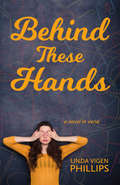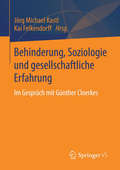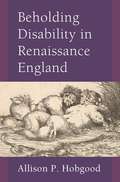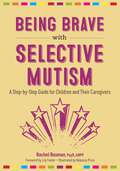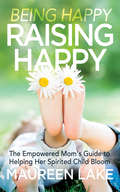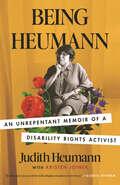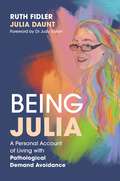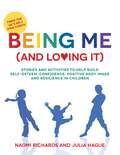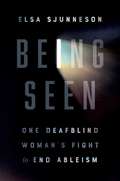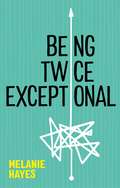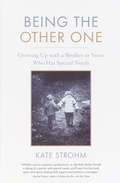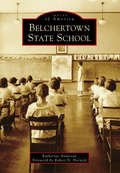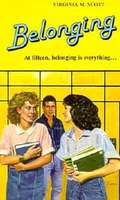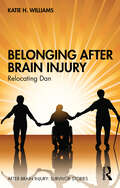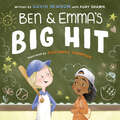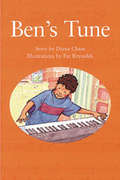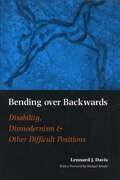- Table View
- List View
Behind These Hands
by Linda Vigen Phillips"A richly woven, unforgettable symphony of feelings and words" –Kirkus Reviews (Starred Review)Piano prodigy Claire Fairchild, 14, has always known music would be her life. So when she has the opportunity to enter a prestigious contest, she goes all in—until she realizes she’s also competing against Juan, a close childhood friend and one of the most talented musicians she knows. It doesn’t help that her thoughts about him are turning romantic.When Claire and her family receive a devastating blow from Batten disease, her world enters a tailspin. Claire decides her musical goals no longer seem relevant.She can’t reconcile the joy that music would bring to her life while her brothers succumb to an early and ugly death. Her decision puts everything at risk: her friendship with Juan, her parents’ expectations, and her own happiness.After Claire accompanies a friend on a school newspaper assignment, she meets a centenarian with a surprising musical past and only one regret in life. Claire knows something in her life has to change before it’s too late, but she’s not sure she has the courage to take the next step.
Behind the Mirror: The Story of a Pioneer in Autism Treatment and Her Work with Children on the Spectrum
by Jeanne Simons Sabine OishiThe life story of Jeanne Simons, whose own autism informed her pioneering work with autistic children.Jeanne Simons devoted her career as a social worker and educator to the study, treatment, and care of children with autism. In 1955, she established the Linwood Children's Center in Ellicott City, Maryland, one of the first schools dedicated to children with autism. Her Linwood Model, developed there, was widely adopted and still forms the basis for a variety of autism intervention techniques. Incredibly—although unknown at the time—Jeanne was herself autistic. Behind the Mirror reveals the remarkable tale of this trailblazer and how she thought, felt, and experienced the world around her. With moving immediacy, Jeanne tells her life story to developmental psychologist, friend, and collaborator Sabine Oishi. Jeanne's unique experience is supplemented by commentary from Dr. Oishi, who explains the importance of key biographical details and fills in additional information about the diagnosis and treatment of autism. Enhanced with a photo gallery, a look at new approaches to the education of children with autism, and a history of Linwood since its founding, the book also contains a foreword, an afterword, and an appendix by James C. Harris, MD, the past director of child psychiatry at Johns Hopkins University School of Medicine and the founder of its autism clinic. Demystifying the experience of autism, Behind the Mirror is a groundbreaking account of possibilities and hope.
Behinderung, Soziologie und gesellschaftliche Erfahrung: Im Gespräch mit Günther Cloerkes
by Jörg Michael Kastl Kai FelkendorffGünther Cloerkes ist einer der wichtigsten europäischen Vertreter einer interaktionistischen Soziologie der Behinderten. Im Zentrum des Bandes stehen Gespräche und Interviews, die Kai Felkendorff und Jörg Michael Kastl mit ihm in den Jahren 2009-2013 geführt haben. Sie werden ergänzt durch Aufsätze von Günther Cloerkes und Jörg Michael Kastl, die historische und systematische Aspekte einer sozial engagierten Soziologie der Behinderten und der Behinderung beleuchten.
Beholding Disability in Renaissance England (Corporealities: Discourses Of Disability)
by Allison P. HobgoodHuman variation has always existed, though it has been conceived of and responded to variably. Beholding Disability in Renaissance England interprets sixteenth- and seventeenth-century literature to explore the fraught distinctiveness of human bodyminds and the deliberate ways they were constructed in early modernity as able, and not. Hobgood examines early modern disability, ableism, and disability gain, purposefully employing these contemporary concepts to make clear how disability has historically been disavowed—and avowed too. Thus, this book models how modern ideas and terms make the weight of the past more visible as it marks the present, and cultivates dialogue in which early modern and contemporary theoretical models are mutually informative. Beholding Disability also uncovers crucial counterdiscourses circulating in the English Renaissance that opposed cultural fantasies of ability and had a keen sensibility toward non-normative embodiments. Hobgood reads impairments as varied as epilepsy, stuttering, disfigurement, deafness, chronic pain, blindness, and castration in order to understand not just powerful fictions of ability present during the Renaissance but also the somewhat paradoxical, surprising ways these ableist ideals provided creative fodder for many Renaissance writers and thinkers. Ultimately, Beholding Disability asks us to reconsider what we think we know about being human both in early modernity, and today.
Being Autistic is Not a Behavior Problem: A Critique of Applied Behavior Analysis in the Era of Neurodiversity
by Daniel B LeGoffApplied behavior analysis (ABA) has become a widely used form of therapy for autistic children without its theories and methods being well understood. This critical analysis of the theories and research on which ABA bases its claim to being an evidence-b
Being Brave with Selective Mutism: A Step-by-Step Guide for Children and Their Caregivers
by Rachel BusmanIf you've picked up this book, talking is probably pretty hard for you. Maybe you really want to talk but feel too nervous to do it when lots of eyes are on you. Perhaps you can talk to certain people but not others or you can only speak a few words in a soft voice. No matter what you are going through, the tips and activities in this book can help you to feel braver about talking.Selective mutism can be tricky to manage. This workbook helps you and your child formulate a plan for exposure activities, and breaks down talking into attainable steps. It includes examples of games to play while practicing talking and offers sample dialogues to illustrate how to do exposures. Pairing a system of rewards along with the exposures helps your child through the challenge of dealing with those uncomfortable feelings. It discusses different situations and places where talking can be difficult and introduces two children, Emily and Jackson, who are both working hard to tackle their selective mutism.Packed full of activities, worksheets and helpful strategies, this book makes putting in the work of being brave around talking fun!
Being Happy, Raising Happy: The Empowered Mom's Guide to Helping Her Spirited Child Bloom
by Maureen LakeAn educator, holistic health coach and mother shares tips for self-care and mental wellness for mothers of strong-willed and highly-sensitive children. You Were Born Happy. You Were Born to Be Happy. You Were Born to Raise Happy. Being a mom is a lot of work. Being a mom of a spirited child can be exceptionally challenging. Moms who want to change their stress and anxiety levels and make a difference in the lives of their children and family need to take steps towards wellness. Maureen Lake teaches moms: · The reason why parenting a spirited child can cause more stress and anxiety than parenting kids who don&’t have the same challenges · The importance of cherishing yourself and setting clear boundaries so you can nurture your child · How to uncover the areas of your life that are causing the most stress and worry · How to regain footing by following a five-step process toward peace of mind · How to better manage family life with a nutrition plan to increase energy and other wellness tips that boost the immune system and create better overall health Being Happy, Raising Happy is for loving and caring moms who somehow forgot about their own desires and the impact they want to make in the world. This accessible guide will help women begin the journey towards revitalizing the mind, body, and spirit. &“Upon reading the first few pages, I was totally hooked. I felt like Maureen was sitting across the table teaching me the importance of taking care of myself and how my wellness will positively impact my child.&” —Gretchen Burman, author of The Adventures of Ooga and Zeeta
Being Heumann: An Unrepentant Memoir of a Disability Rights Activist
by Judith Heumann Kristen JoinerSoon to be an Apple feature movie directed by CODA&’s Sian Heder and starring BAFTA-nominated actress Ruth Madeley as Judy Heumann"This important book will help ensure that every person gets a chance to live up to their full potential and will always have a place at the table.&”—Hillary Clinton"Her life story as an activist will enlighten readers everywhere.&”—Gloria Steinem"Her fierce advocacy and work changing the laws around disability rights have undeniably paved the way for me to achieve what I have today. . . . A must-read.&”—Ali Stroker, Tony Award–winning actressOne of the most influential disability rights activists in US history tells her personal story of fighting for the right to receive an education, have a job, and just be humanA story of fighting to belong in a world that wasn&’t built for all of us and of one woman&’s activism—from the streets of Brooklyn and San Francisco to inside the halls of Washington—Being Heumann recounts Judy Heumann&’s lifelong battle to achieve respect, acceptance, and inclusion in society.Paralyzed from polio at eighteen months, Judy&’s struggle for equality began early in life. From fighting to attend grade school after being described as a &“fire hazard&” to later winning a lawsuit against the New York City school system for denying her a teacher&’s license because of her paralysis, Judy&’s actions set a precedent that fundamentally improved rights for disabled people.As a young woman, Judy rolled her wheelchair through the doors of the US Department of Health, Education, and Welfare in San Francisco as a leader of the Section 504 Sit-In, the longest takeover of a governmental building in US history. Working with a community of over 150 disabled activists and allies, Judy successfully pressured the Carter administration to implement protections for disabled peoples&’ rights, sparking a national movement and leading to the creation of the Americans with Disabilities Act.Candid, intimate, and irreverent, Judy Heumann&’s memoir about resistance to exclusion invites readers to imagine and make real a world in which we all belong.
Being Julia - A Personal Account of Living with Pathological Demand Avoidance
by Ruth Fidler Julia DauntDiagnosed with Pathological Demand Avoidance (PDA) at aged 12 and writing this memoir at age 37, Julia Daunt depicts the ins and out of PDA and its symptoms, while maintaining a positive outlook on what is possible to achieve. Co-written with professional specialist Ruth Fidler, it covers how PDA impacts Julia's life, including meltdowns, sensory issues and communication in relationships.Including examples of school reports and handwritten letters, a chapter written from Julia's partner's perspective and even an example of Julia's favourite recipe, this warm and personal look at living and thriving with PDA is informative and inspiring.
Being Legally Blind: Observations for Parents of Visually Impaired Children
by Justin OldhamAll parents face a mix of joys and challenges when welcoming a new child into the family. Being told that your new son or daughter has a visual disability makes the task of sharing the world with that child seem much more daunting. It will be difficult, but it is an adventure which you both can survive. This book will provide you with some insight into the obstacles you will face, pitfalls to be avoided, joys to be shared, and hope for what is to come. What expectations should you have? What resources are available to assist your child? Where do you find them? Is it possible for your child to become a happy, successful member of society? This book addresses these questions and others, with a foreword by ophthalmologist and eye surgeon Griffith C. Steiner, M. D.
Being Me (and Loving It): Stories and activities to help build self-esteem, confidence, positive body image and resilience in children
by Julia Hague Naomi RichardsWith 29 real life and relatable stories at its heart, this practical resource is designed to help build self-esteem and body confidence in children aged 5-11. Each story is the focus of a ready-to-use lesson plan, covering common issues that affect children such as a lack of body confidence, feeling pressured by peers and worries about puberty. The stories are preceded by guidance on how to introduce the topic and the learning outcomes, and they are followed by a range of activities to reinforce the messages being taught. The stories can either be read aloud to a class or group or photocopied and shared for individual reading. Perfect for use in PSHE lessons with groups of children, or in one-to-one settings in the therapy room or at home, this book is a useful resource for PSHE co-ordinators, teachers, school counsellors, pastoral care teams, youth workers as well as parents.
Being Seen: One Deafblind Woman's Fight to End Ableism
by Elsa SjunnesonA deafblind writer and professor explores how the misrepresentation of disability in books, movies, and TV harms both the disabled community and everyone else.As a deafblind woman with partial vision in one eye and bilateral hearing aids, Elsa Sjunneson lives at the crossroads of blindness and sight, hearing and deafness—much to the confusion of the world around her. While she cannot see well enough to operate without a guide dog or cane, she can see enough to know when someone is reacting to the visible signs of her blindness and can hear when they&’re whispering behind her back. And she certainly knows how wrong our one-size-fits-all definitions of disability can be. As a media studies professor, she&’s also seen the full range of blind and deaf portrayals on film, and here she deconstructs their impact, following common tropes through horror, romance, and everything in between. Part memoir, part cultural criticism, part history of the deafblind experience, Being Seen explores how our cultural concept of disability is more myth than fact, and the damage it does to us all.
Being Twice Exceptional
by Melanie HayesTwice exceptionality (2e) is not well understood. While many parents, educators, and professionals are working to bridge the knowledge gap and help 2e children, there is still a great deal we do not know about how life turns out for those children once they grow up.How do 2e adults deal with the complex aspects of being an adult? What are your prospects if you are brilliant, but can't get into college? What if you fail at work because you don't know how to fit in socially? This book provides first-hand stories about the experiences of 2e adults, offering compassionate coping strategies for overcoming and rethinking the tough parts. It champions radical acceptance of 2e people and celebrates their unique outlook on the world.
Being the Other One: Growing Up With A Brother Or Sister Who Has Special Needs
by Kate StrohmWhen there's a disabled child in the family, how are normally developing siblings affected? According to Kate Strohm, a counselor and health educator, siblings of the disabled face particular emotional challenges that are often overlooked. Able siblings commonly struggle with feelings of isolation, grief, anger, and anxiety—and these and other emotional issues can have lifelong effects.Being the Other One is based on the author's own experience (as a sibling of a sister with cerebral palsy) and on extensive interviews she conducted with siblings of all ages. In clear and compassionate terms, Strohm explores the often secret feelings of siblings and offers valuable strategies for coping with the challenges they face.Being the Other One reveals the difficulties faced by siblings at all stages of life, from early childhood through adulthood, when siblings must often assume responsibility for the care of their disabled brothers and sisters. Though the book looks honestly at the many challenges that siblings face, it is full of encouragement and practical strategies. Strohm emphasizes that when siblings are able to clearly identify and openly express their feelings and concerns—and when parents and health professionals offer the needed support—siblings can thrive. This book includes writing exercises for personal exploration and a substantial resources section listing helpful books, organizations, and websites.
Belchertown State School (Images of America)
by Katherine AndersonIn the first decade of the 20th century, the state of Massachusetts established itself as a leader in the education of individuals with disabilities. The third state school for the feebleminded was built in rural Belchertown, in the western part of the state. Opened in 1915, Belchertown State School would eventually encompass almost 900 acres of land and would become the largest employer in town. For nearly 60 years, the state school educated individuals with disabilities who were otherwise excluded from public education, training the "residents" to become independent members of their families and of society. The model was a success until reports of abuse and neglect began to surface, culminating in the landmark 1972 Ricci v. Greenblatt case, which ultimately led to the state school's closure in 1992. The state school's rich history, maintained and curated by the late Donald LaBrecque, chronicles the rise of special education and developmental services and the ultimate collapse of the state school system.
Belonging
by Deborah KentAfter years in a special class for blind students, fifteen-year-old Meg persuades her parents to let her attend the local high school. Afraid that she will have a hard time, her parents agree to let her try for a semester. Meg longs to join the in crowd at school, and struggles for a way to fit in. Some new friends and an inspiring, though troubled, teacher help her gain a deeper understanding of who she is.
Belonging
by Virginia M. Scott<P>Gustie Blaine had it all--she was a cheerleader and an honor-roll student, she even got along with her parents--until the summer of her fifteenth year. That summer she got meningitis. It started with a headache, but in the end the illness left her deaf. Belonging is the story of how Gustie's life changed after that illness. <P>Gustie spent the first months of her recovery with hearing that yo-yoed. One day she could hear just about everything people said; the next, she understood almost nothing. She tried hearing aids, but they only made the garbled sounds louder, not clearer. <P>By the following winter her hearing was completely gone. Her best friend and confidante, Sara, suddenly had no time for her. School became a nightmare. She couldn't understand most of what was said in her classes. It was nearly impossible to keep up. <P>Gustie lived in a hearing world, and she felt cut off from everything and everyone. Even her parents. The old ease between them was now strained; accepting her hearing loss was hard. Traditions that the family had taken for granted, like sitting around the Christmas tree and listening to carols, were now impossible. <P>Gradually though, Gustie began to find new friends, like Lenore, a classmate who wasn't afraid of Gustie's deafness. She met Mr. Tate, a special education teacher, who showed her she still had choices, even in finding a way to communicate. And most importantly, she met Jack. He thought of her deafness as "part of the whole package."
Belonging After Brain Injury: Relocating Dan (After Brain Injury: Survivor Stories)
by Katie H. WilliamsBelonging After Brain Injury: Relocating Dan explores the life of the author’s brother who has dealt with the effects of a severe traumatic brain injury (TBI) for over four decades. It recounts the institutional, psychological, and social labyrinths he and his family have navigated following the TBI he sustained at the age of eighteen. This insightful volume offers a holistic account of the impact of TBI on the survivor and his family. It reveals the difficulties a TBI survivor has had to endure and provides practical information about physical, psychological, and psychosocial symptoms and their consequences. Dan’s story offers new perspectives and strategies that will help alleviate seemingly intractable problems and highlights the central importance of forming connections with others in order to lead a fuller life. The author’s account of her own journey, learning to help care for and advocate for Dan, offers an invaluable guide for TBI survivors and those who care for and support them. Belonging After Brain Injury: Relocating Dan will be of interest to TBI survivors and their families. Its rich insights will be essential reading for medical and mental health professionals, as well those involved in the care and rehabilitation of TBI survivors and families.
Belonging: Accessibility, Inclusion, and Christian Community (LifeGuide Bible Studies)
by Deborah Meyer AbbsGod created all of us for relationship with God and each other. Yet most people have felt left out at some point. For those with visible or invisible disabilities, attitudes and systems of ableism can particularly lead to deep hurt and barriers to fully participating in God's kingdom work. We all miss out when any members of the body of Christ are not included. In this nine-session LifeGuide Bible study, Deborah Abbs guides you to explore the deep love and acceptance of our heavenly Father and what it means for offering love and acceptance to one another. Through Old and New Testament stories and teachings on Christian community, we see how God responds in love to those who are often marginalized and excluded so that we too can welcome people of all different abilities. For over three decades LifeGuide Bible Studies have provided solid biblical content and raised thought-provoking questions—making for a one-of-a-kind Bible study experience for individuals and groups. This series has more than 130 titles on Old and New Testament books, character studies, and topical studies.
Ben Takes a Chance (Making Out, Book 11)
by Katherine ApplegateBen and Nina are going beyond making out as the day for Ben's eye surgery approaches. First they have to get through Christmas. The surgery could make Ben's blindness a problem of the past. The island kids are uncertain about their relationships. There's a lot on their minds besides Santa. Christopher is set up to leave for the Army. For Christmas he wants a yes to his marriage proposal from Aisha. Aisha loves Christopher but thinks the middle of her senior year is a little soon to be planning her wedding. Zoey is heart broken that Lucas is angry at her for making out with Aaron, but at the same time she's attracted to Aaron and he's encouraging her. Meanwhile Claire is sure Aaron is the man for her even though Aaron hasn't shown any interest beyond glancing at her legs. With Jake and Lara, sleeping together isn't about love. It's more about the alcohol and drugs that can ruin their lives. Once you've seen them through Christmas, find out what awaits them in the new year in Claire Can't Lose, Making Out #12. You can read More of the Making Out series books in Bookshare collection. They are: #1 Zoey Fools Around, #2 Jake Finds Out, #3 Nina Won't Tell, #4 Ben's In Love, #5 Claire Gets Caught, #6 What Zoey Saw, #7 Lucas Gets Hurt, #8 Aisha Goes Wild, #9 Zoey Plays Games, #10 Nina Shapes Up, #11 Ben Takes A Chance, #12 Claire Can't Lose, #13 Don't Tell Zoey, #14 Aaron Lets Go, #15 Who Loves Kate?, #16 Lara Gets Even, #17 Two Timing Aisha, #18 Zoey Speaks Out and #19 Kate Finds Love. With more to come.
Ben and Emma's Big Hit
by Gavin Newsom Ruby ShamirFrom California Governor Gavin Newsom comes an empowering picture book about a young boy with dyslexia who discovers a new way to look at reading.Ben loves baseball. He loves the lines of diamond-shaped field and the dome of the pitcher's mound. What Ben doesn't like is reading. Ben has dyslexia, which means letters and sounds get jumbled up in his brain, and then the words don't make sense. But when Ben starts looking at reading like he looks at baseball, he realizes that if he keeps trying, he can overcome any obstacle that comes his way.In this empowering story by California Governor Gavin Newsom, inspired by his own childhood diagnosis of dyslexia, readers will learn that kids with the determination to try (and try again) can do big things. *This book is set in a font specifically designed to be easier for people with dyslexia to read.
Ben the Bubble Bear: Targeting the b Sound (Speech Bubbles 1)
by Melissa PalmerBen the bear loves to blow bubbles, but what happens when he tries to blow the biggest bubble in the world? This picture book targets the /b/ sound, and is part of Speech Bubbles 1, a series of picture books that target specific speech sounds within the story. The series can be used for children receiving speech therapy, for children who have a speech sound delay/disorder, or simply as an activity for children’s speech sound development and/or phonological awareness. They are ideal for use by parents, teachers or caregivers. Bright pictures and a fun story create an engaging activity perfect for sound awareness. Please see other titles in the series for stories targeting other speech sounds.
Ben's Tune (Rigby PM Collection Ruby (Levels 27-28), Fountas & Pinnell Select Collections Grade 3 Level Q)
by Pat Reynolds Diana ChaseBen was born with one hand much smaller than the other. But this doesn't stop him thumping out tunes on the piano. The problem is that music teachers won't give Ben a chance to prove how well he can play.
Bending Over Backwards: Essays on Disability and the Body (Cultural Front #6)
by Lennard J. DavisWith the advent of the human genome, cloning, stem-cell research and many other developments in the way we think of the body, disability studies provides an entirely new way of thinking about the body in its relation to politics, the environment, the legal system, and global economies. Bending Over Backwards reexamines issues concerning the relationship between disability and normality in the light of postmodern theory and political activism. Davis takes up homosexuality, the Americans with Disabilities Act, the legal system, the history of science and medicine, eugenics, and genetics. Throughout, he maintains that disability is the prime category of postmodernity because it redefines the body in relation to concepts of normalcy, which underlie the very foundations of democracy and humanistic ideas about the body. Bending Over Backwards argues that disability can become the new prism through which postmodernity examines and defines itself, supplanting the categories of race, class, gender, and sexual orientation.
Benito The Blind Boy
by Tammy RugglesA little boy becomes blind and wonders if he can do all the things he loves.
